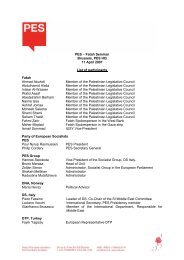Hedge funds and Private Equity - PES
Hedge funds and Private Equity - PES
Hedge funds and Private Equity - PES
You also want an ePaper? Increase the reach of your titles
YUMPU automatically turns print PDFs into web optimized ePapers that Google loves.
from the tourism business, which is closely linked to the business cycle, with better results from<br />
shipping. However, as Hapag-Lloyd had moved into loss owing to higher fuel cost <strong>and</strong> lower<br />
freight prices, this strategy was now questioned by the investment <strong>funds</strong>.<br />
The employee representatives on the supervisory board produced a statement in September<br />
2006, expressing their support for the concept of an integrated tourism business <strong>and</strong> the twopillar<br />
strategy. In addition, trade union representatives have already sought a meeting with the<br />
mayor of Hamburg <strong>and</strong> further measures are being prepared.<br />
In January, 2007 Richard Mayer, an infamous private investor, as a TUI stockholder appeared. This<br />
had provided in the past at numerous companies as an uncomfortable <strong>and</strong> critical stockholder<br />
for headlines. Mayer dem<strong>and</strong>s in the same way like some institutional investors, among them<br />
DWS <strong>and</strong> Hermes, the splitting off <strong>and</strong> the sales of Hapag-Lloyd.<br />
At the beginning of February the press for 2006 announced an expected loss of the TUI AG of<br />
about 900 Mil. EUR. In 2005 TUI had achieved one more profit of 495 Mil. EUR. Following<br />
causes were responsible for the high loss: An “Impairment test” to IFRS, the international balance<br />
st<strong>and</strong>ard, proved goodwill depreciations at the rate of 700 Mil. EUR. The biggest interest<br />
(500 Mil. EUR) of the depreciations arises by the goodwill depreciations on the British Thomson<br />
Travel Group assumed in 2000. Other 60 Mil. EUR came at by goodwill depreciation of the<br />
French subsidiary firm Nouvelles Frontieres. In addition, the result is loaded by high expenditures<br />
of 100 Mil. EUR for the reorganisation of the tourism business <strong>and</strong> 110 Mil. EUR for the integration<br />
of the Canadian CP Ships assumed in 2005. The company capital rate thereby falls on<br />
approx. 20%.<br />
2.2 Debt structure, alteration of company capital management<br />
fees requested by LBO<br />
The transformation of the steel company Preussag AG into the tourism business TUI AG<br />
resulted in a sharp increase in the company’s level of debt, in which a substantial proportion of<br />
the external capital provided was refinanced through bonds issued on the capital market. After<br />
a period in which the company consistently reduced its level of debt, with the aim of obtaining<br />
as positive a credit rating as possible, in 2005 it issued further bonds to finance the purchase<br />
of the Canadian shipping company CP Ships, for which it paid approximately €2 billion. On<br />
31 December 2005 the level of debt was about 64%.<br />
2.3 Effects on job creation, investments in training<br />
<strong>and</strong> education of labour force, investments in innovation<br />
The aim of the management board chairman, Michael Frenzel, is to double operating earnings<br />
to €1.3 billion, something which cannot be achieved with the tourist business alone, given its low<br />
margins. Under the pressure of the capital markets, the company has for years implemented cost<br />
reduction <strong>and</strong> restructuring programmes. Its current programme “One Company” is intended to<br />
save around €50 million. The plans include slimming down <strong>and</strong> providing a new organisation for<br />
the travel business, particularly in the main market, Germany. Since 2002 some 6,000 jobs have<br />
already gone in the tourism division. A further 2,000 jobs are to be lost worldwide as a result of<br />
the takeover of the Canadian shipping company at the end of 2005, although 100 additional<br />
jobs are to be created in the Hamburg headquarters.<br />
Annex – 21 Case studies<br />
235




